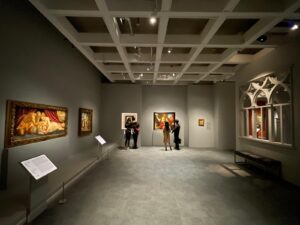
During this Lunar New Year, or ‘Spring Festival’ celebrating the beginning of the Year of the Dragon, I spent several days in Asia. On the last evening of the trip, before my flight returning from Hong Kong to the other side of the globe, I decided to spend the last few hours visiting the Hong Kong Museum of Art to view an exhibition co-organized by the Uffizi Galleries from Florence, Italy.
Titian’s spring Goddess in the Spring Festival
The exhibition was titled ‘The Hong Kong Jockey Club Series: Titian and the Venetian Renaissance from the Uffizi,’ displaying fifty works by some of the greatest painters in history, including Titian (Italian: Tiziano), Giorgione, Tintoretto, and Veronese from the Venetian School, spanning the 14th to the 18th century.
Hopping onto Hong Kong’s Star Ferry on the gentle waves and in the warm, moist breeze from the sea—a pleasantly nostalgic trip down memory lane in itself—I crossed to the Kowloon side of Victoria Bay. From there, I walked through the celebrating crowds to the main entrance of the Hong Kong Museum of Art, up the stairs, and toward the entrance of the exhibition, where Titian’s painting ‘Flora’, or goddess of spring, finally emerged.
Intersection of time, space, and cultures
 Standing in front of Titian’s paintings, next to the museum’s massive glass wall overlooking the brightly-lit festive Hong Kong waterfront, I found myself at the fascinating intersection of parallel worlds. On one side, the timeless masterpieces of the Italian Renaissance; on the other, the fleeting moments of the New Year. On one side, the modern city of Hong Kong and the ancient Eurasian continent where I grew up; on the other, just a flight cabin away, the continent of the Americas. On one side, the East; on the other, the West.
Standing in front of Titian’s paintings, next to the museum’s massive glass wall overlooking the brightly-lit festive Hong Kong waterfront, I found myself at the fascinating intersection of parallel worlds. On one side, the timeless masterpieces of the Italian Renaissance; on the other, the fleeting moments of the New Year. On one side, the modern city of Hong Kong and the ancient Eurasian continent where I grew up; on the other, just a flight cabin away, the continent of the Americas. On one side, the East; on the other, the West.
For a brief moment, the vision of a global village, imagined and celebrated by many at the turn of the century, almost seemed a reality. I had a flashback to New Year’s Eve of 2000, when my friends and I cheered on the Bund in the city of Shanghai under a night sky also brightly-lit by skyscrapers and fireworks on the Yangtze River. That night, perhaps many others around the world were dreaming the same.
Relevance of the Renaissance
A quarter of a century later, the world might have turned out differently than what was imagined in 1999. To be fair, no one could have foreseen the future. For instance, decades ago, films and TV series vividly and optimistically imagined a 2000s when humans would be traversing the solar system and beyond.
But at least, humanity has the timeless beauty of art from the Renaissance. For over five hundred years, the warm gaze of Titian’s Flora has transcended time, space, and culture. Beyond beauty, the Renaissance was also a time of discovery, learning, exploration, and connectivity, leading to important advancements in art, architecture, science, and technology.
Five hundred years later, will there be another period of rapid development in civilization? Today, there is much enthusiasm around artificial intelligence (AI). Beneath the hype, there is perhaps a sense of collective optimism. If human intelligence has not solved our recurring problems for such a long time, maybe we could create technologies capable of addressing those problems. Just like during the Renaissance, the study of the human body and mind led to the creation of technologies that extended human intelligence.
AI and Art
In the field of art, for example, AI can have a profound impact by significantly transforming the creative process and enabling new forms of expression. For instance, in a growing field called algorithmic art, artists can leverage generative AI algorithms to create images, patterns, and styles based on algorithms’ learning from large datasets of existing artworks. In another AI-based technique called style transfer, algorithms can combine the content and artistic techniques from different sources and sometimes create innovative and interesting results; many such examples can be found on DALL.E of OpenAI and other applications.
Overall, AI has the capacity to augment, automate, and assist in all activities of human artists’ creative journey, from idea generation, to experimentation, to execution. AI can also facilitate adjacent activities surrounding and supporting the creative process, from art restoration and preservation, to commercialization in some cases, to outreach, curation and education.
Search for the Next Renaissance?
Beyond art, more broadly, some believe humanity could be on the cusp of an era analogous to Renaissance. Professor Yann LeCun, a computer scientist and recipient of the Turing Award for the work on artificial intelligence, wrote: “The world needs more intelligence. The amplification of human intelligence by machine intelligence will enable a new Renaissance, a new period of Enlightenment.”
That is why revisiting the Italian Renaissance is perhaps especially relevant and timely today.
***
Alley Oop’s newsletter
Every Friday morning Alley Oop arrives in your inbox with news and stories. To sign up, click here.
If you want to write to or contact Alley Oop’s editorial team, email us at alleyoop@ilsole24ore.com.